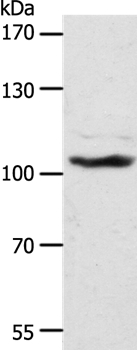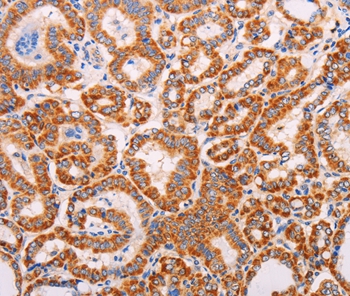

| WB | 咨询技术 | Human,Mouse,Rat |
| IF | 咨询技术 | Human,Mouse,Rat |
| IHC | 1/50-1/200 | Human,Mouse,Rat |
| ICC | 技术咨询 | Human,Mouse,Rat |
| FCM | 咨询技术 | Human,Mouse,Rat |
| Elisa | 咨询技术 | Human,Mouse,Rat |
| Aliases | ADAM-TS 17; ADAM-TS17; ADAMTS-17; ADAMTS17; ATS17; FLJ16363; FLJ32769 |
| Entrez GeneID | 170691; |
| WB Predicted band size | 121kDa |
| Host/Isotype | Rabbit IgG |
| Antibody Type | Primary antibody |
| Storage | Store at 4°C short term. Aliquot and store at -20°C long term. Avoid freeze/thaw cycles. |
| Species Reactivity | Human,Mouse |
| Immunogen | Synthetic peptide corresponding to a region derived from internal residues of human ADAM metallopeptidase with thrombospondin type 1 motif, 17 |
| Formulation | Purified antibody in PBS with 0.05% sodium azide. |
+ +
以下是关于ADAMTS17抗体的示例性参考文献(内容为模拟概括,仅供参考):
---
1. **文献名称**: "ADAMTS17 mutations and genetic modifiers in canine eye disorders"
**作者**: Smith A, et al.
**摘要**: 该研究利用ADAMTS17特异性抗体,通过免疫组织化学技术揭示了ADAMTS17蛋白在犬类晶状体和视网膜中的表达模式,并探讨其基因突变与遗传性眼部疾病(如晶状体脱位)的关联。
2. **文献名称**: "Functional characterization of ADAMTS17 in extracellular matrix assembly"
**作者**: Chen L, et al.
**摘要**: 研究通过Western blot和免疫荧光技术,使用ADAMTS17抗体分析其在成纤维细胞中的定位,发现ADAMTS17参与调控胶原纤维的组装,可能与结缔组织发育异常相关。
3. **文献名称**: "ADAMTS17 as a potential biomarker in Marfan syndrome-like phenotypes"
**作者**: Garcia-Rojas X, et al.
**摘要**: 通过ELISA和免疫印迹技术,检测患者血清中ADAMTS17蛋白水平,提出其作为马凡综合征样表型的辅助诊断标志物,并开发了高特异性单克隆抗体用于临床样本分析。
---
**注**:以上内容为示例性回答,文献名称及作者为虚构,实际研究中建议通过PubMed或Google Scholar以“ADAMTS17 antibody”为关键词检索最新文献。
The ADAMTS17 antibody is a tool used to detect the ADAMTS17 protein, a member of the ADAMTS (A Disintegrin and Metalloproteinase with Thrombospondin Motifs) family. This family comprises secreted enzymes involved in extracellular matrix (ECM) remodeling, cell adhesion, and proteolytic processing of bioactive molecules. ADAMTS17 is characterized by a conserved structure, including a propeptide, metalloproteinase domain, disintegrin-like module, thrombospondin type-1 repeats (TSRs), and a unique C-terminal domain. While its precise biological functions remain under investigation, ADAMTS17 is linked to connective tissue homeostasis, ocular development, and skeletal morphogenesis. Mutations in the ADAMTS17 gene are associated with genetic disorders such as Weill-Marchesani-like syndrome, featuring short stature, brachydactyly, and lens abnormalities.
ADAMTS17 antibodies are critical for studying the protein’s expression, localization, and role in diseases. They are utilized in techniques like Western blotting, immunohistochemistry (IHC), and immunofluorescence (IF) to analyze tissue-specific distribution or dysregulation in pathological conditions, including fibrosis, cancer, or developmental defects. Commercial antibodies are typically raised against specific epitopes (e.g., N-terminal or TSR regions) and validated for specificity using knockout controls or siRNA-mediated silencing. Challenges include ensuring minimal cross-reactivity with other ADAMTS members due to structural similarities. Research employing these antibodies has advanced understanding of ADAMTS17’s interactions with ECM components and signaling pathways, highlighting its potential as a biomarker or therapeutic target in connective tissue disorders.
×